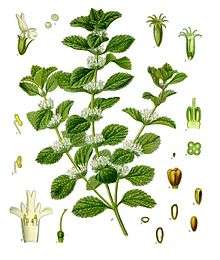Marrubium vulgare
Marrubium vulgare (white horehound or common horehound) is a flowering plant in the mint family (Lamiaceae), native to Europe, northern Africa, and southwestern and central Asia. It is also widely naturalized in many places, including most of North and South America.
| White horehound | |
|---|---|
 | |
| Marrubium vulgare[1] | |
| Scientific classification | |
| Kingdom: | Plantae |
| Clade: | Tracheophytes |
| Clade: | Angiosperms |
| Clade: | Eudicots |
| Clade: | Asterids |
| Order: | Lamiales |
| Family: | Lamiaceae |
| Genus: | Marrubium |
| Species: | M. vulgare |
| Binomial name | |
| Marrubium vulgare | |
It is a grey-leaved herbaceous perennial plant, and grows to 25–45 centimetres (10–18 in) tall. The leaves are 2–5 cm (0.8–2.0 in) long with a densely crinkled surface, and are covered in downy hairs. The flowers are white, borne in clusters on the upper part of the main stem.
Etymology
The Oxford English Dictionary derives the word from two Old English forms: "hoar" ("white," "light-colored," as in "hoarfrost") and "hune" a word of unknown origin designating a class of herbs or plants. The second element was altered by folk etymology.
Medicinal usage
Historical

Horehound has been mentioned in conjunction with medicinal use dating at least back to the 1st century BC, where it appeared as a remedy for respiratory ailments in the treatise De Medicina by Roman encyclopaedist Aulus Cornelius Celsus.[2] The Roman agricultural writer Columella lists it as a remedy for expelling worms in farm animals in his important first-century work On Agriculture.[3] Since then, horehound has appeared for similar purposes in numerous herbals over the centuries, such as The Herball, or, Generall historie of plantes by John Gerard, and Every Man His Own Doctor: or, The Poor Planter’s Physician by Dr. John Tennent.[4]
Modern
M.vulgare has been promoted widely on the internet for its supposed therapeutic purposes, and there has been preliminary research into its medicinal properties.[5] Nevertheless as of 2016 there is no good evidence that it has any value as a medicine.[5] The U.S. Food and Drug Administration does not endorse the plant for use as medicine, but has declared it to be a generally safe food additive.[6]
Horehound candy

Horehound drops are bittersweet hard candies made with sugar and an extract of M.vulgare. They are dark-colored, dissolve in the mouth, and have a flavor that has been compared to menthol and root beer. Like other products derived from M.vulgare, they are sometimes used as an unproven folk treatment for coughs and other ailments.[7][8]
Drinks
M.vulgare is used to make beverages such as horehound beer, horehound tea (similar to the Maghrebi mint tea), and the rock and rye cocktail.[9]
As an invasive weed
Horehound was introduced to southern Australia in the 19th century as a medicinal herb. It became a weed of native grasslands and pastures where it was introduced with settlers’ livestock, and was first declared under noxious weeds legislation. It now appears to have reached its full potential distribution.
In New Zealand efforts are being made to control its spread with biocontrol measures using the horehound clearwing moth Chamaesphecia mysiniformis and the horehound plume moth Wheeleria spilodactylus that could eat their way through many plants.[10]
It occupies disturbed or overgrazed ground, and is favoured by grazing because it is highly unpalatable to livestock. It may persist in native vegetation that has been grazed.
As biocontrol
Marrubium vulgare is also used as a natural grasshopper repellent in agriculture.
In astrology
According to John Gower in Book 7 of the Confessio Amantis, this plant was the herb of the fourth star of Nectanebus' astrology, Capella. Gower uses the older name, Alhaiot (VII:1338).
Gallery
- Wild horehound
 Flowers
Flowers Foliage of young plants
Foliage of young plants Horehound bug, a common insect that feeds on white horehound
Horehound bug, a common insect that feeds on white horehound
See also
References
- Franz Eugen Köhler, 1897, Köhler's Medizinal-Pflanzen
- "LacusCurtius • Celsus — On Medicine — Book IV". Penelope.uchicago.edu. Retrieved 21 January 2018.
- "Full text of "On agriculture, with a recension of the text and an English translation by Harrison Boyd Ash"". Archive.org. Retrieved 21 January 2018.
- Dr. John Tennent. "Every Man His Own Doctor: OR, The Poor Planter's Physician, ca. 1727" (PDF). Nationalhumanitiescenter.org. Retrieved 21 January 2018.
- Rodríguez Villanueva J, Martín Esteban J (October 2016). "An Insight into a Blockbuster Phytomedicine; Marrubium vulgare L. Herb. More of a Myth than a Reality?". Phytother Res (Review). 30 (10): 1551–1558. doi:10.1002/ptr.5661. PMID 27271209.
- Foster, Steven; Tyler, Varro E.; Tyler, Virginia M. (1999). Tyler's Honest Herbal: A Sensible Guide to the Use of Herbs and Related Remedies. Psychology Press. p. 218. ISBN 9780789007056.
- Vandersteen, Eric. Horehounds Are the Old-School Candy You're Missing Out On. Saveur.
- Sharrock, Jane (2004-08-03). Who Wants Candy?. Penguin. p. 50. ISBN 9781440625534.
- "Rock & Rye - Imbibe Magazine". Imbibemagazine.com. Retrieved 21 January 2018.
- "Moths may be the key to controlling spreading infestations of horehound". Retrieved 9 May 2019.
Further reading
- Everist, D.L. (1981) Poisonous Plants of Australia. 3rd edn (Angus & Robertson: Sydney). ISBN 0-207-14228-9
- Parsons, W. & Cuthbertson, E. (2001) Noxious Weeds of Australia. 2nd edn (CSIRO Publishing: Collingwood). ISBN 0-643-06514-8
External links

- Jepson Manual Treatment